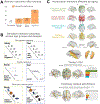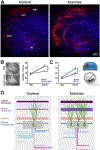Exercise and Hippocampal Memory Systems
- PMID: 30777641
- PMCID: PMC6422697
- DOI: 10.1016/j.tics.2019.01.006
Exercise and Hippocampal Memory Systems
Abstract
No medications prevent or reverse age-related cognitive decline. Physical activity (PA) enhances memory in rodents, but findings are mixed in human studies. As a result, exercise guidelines specific for brain health are absent. Here, we re-examine results from human studies, and suggest the use of more sensitive tasks to evaluate PA effects on age-related changes in the hippocampus, such as relational memory and mnemonic discrimination. We discuss recent advances from rodent and human studies into the underlying mechanisms at both the central and peripheral levels, including neurotrophins and myokines that could contribute to improved memory. Finally, we suggest guidelines for future research to help expedite well-founded PA recommendations for the public.
Keywords: aging; growth factors; hippocampus; myokines; neurogenesis; pattern separation; physical activity; relational memory.
Copyright © 2019 Elsevier Ltd. All rights reserved.
Figures


References
-
- Leshner AI et al. (2017) Preventing Cognitive Decline and Dementia: A Way Forward. - PubMed
Publication types
MeSH terms
Grants and funding
LinkOut - more resources
Full Text Sources
Medical
Research Materials

